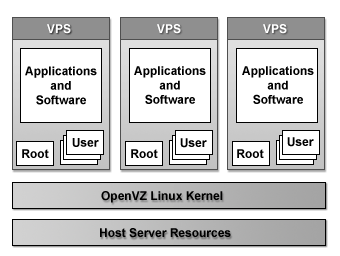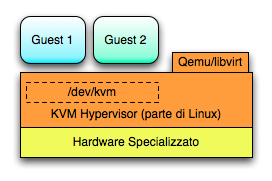Thanks to Ivan Zini and the Linux Day held at Bologna the last Saturday I’ve discovered a new interesting tool for managing Virtual machines: Proxmox Ve
Most of the images and information are taken from the presentation of Ivan, this is available online (in Italian) at the Erlug Linux Day page.
Proxmox Ve is an Open Source project developed and maintained by Proxmox Server Solutions GmbH in Austria under the auspices of the Internet foundation of Austria (IPA) and it’s released under the GNU General public license 3. It is a solution based on Debian 6 Squeeze at 64 bit, which duly “customized”, allows to create a virtualization environment of type “bare metal” based on OpenVZ and KVM technologies.
Proxmox VE is designed to fully exploit the power and performance of the hardware, for use in real business workloads, and is, version after version, increasingly turned to the enterprise.
Some of its features are:
- Based on Debian 6 – 64 bit
- Broad hardware support
- Host support for Linux and Windows at 32 and 64 bits
- Support for the latest Intel and AMD chipset
- Optimization for the bare-metal virtualization to support high workloads.
- Web management with all the features necessary to create and manage a virtual infrastructure.
- Management through web interface without needing to use any client software.
- Combination of two virtualization technology KVM and OpenVZ
And now some details on the supported Virtualization softwares:
OpenVZ
It is a virtualization technology based on the linux kernel; allows you to create and isolate multiple instances (containers) of the same operating system (linux). Each container, although it shares the host kernel, behaves exactly like a stand-alone server; It can be rebooted independently and have its own root user, users, IP addresses, memory, processes, applications, system libraries and configuration files.
It is a technology used by internet providers that use linux instances for web servers, databases or e-mail systems. Windows cannot run on OpenVZ.
Proxmox uses this technology since the beginning of the project, more than 5 years of experience.
KVM
Kernel-based Virtual Machine is a virtualization technology that consists of a module (kvm.ko) integrated in the linux kernel (from the 2.6.20 release) that uses the processor’s extensions to the virtualization (Intel VT and AMD-V). Unlike OpenVZ, KVM allows you to create multiple independent virtual machines from the host kernel on which to run unmodified versions of Linux, Windows, Open/Free BSD and Solaris. KVM in itself does not perform any emulation, but allows hardware virtualization management, exposing its capabilities to a second component that takes care of the emulation of virtual machines: Qemu. KVM is a layer between requests made by Qemu and the kernel.
Some details on Proxmox features
Live Migration & Cluster HA
Proxmox VE can be run as an HA Cluster (Hight Available) or in a mode with a configuration that is based on a primary node, the master, and the other nodes are called slaves. These nodes are connected together to form, from a logical point of view, a single large computer.
With the implementation of a cluster, you can balance the workload on different hosts, increasing availability of virtual machines.
In addition, you can perform real-time live migration of virtual machines, even if you don’t have shared storage.
In case of hardware maintenance, you can move the virtual machines on another node without any downtime, (or limited downtime).
In simple terms, if a virtual machine or container (VM or CT) is configured as HA and there is a physical host failure the VM is restarted automatically on one of the other nodes in a cluster.
So with the Live Migration, we can move running virtual servers from one physical host to another without downtime.
KVM
The migration of a virtual machine, running from one physical host to another, is done without any interruption. In order to use the live migration, all virtual disks must reside on shared storage, between hosts, as a SAN or NAS,
OpenVZ
It’s possible to achieve containers migration without downtime, even using local storage, so shared storage is not required. (No San or Nas)
Backup e Restore
The integrated backup tool (vzdump) creates snapshots of virtual guests both for OpenVZ and KVM.
In practice it creates a tarball of the VM or CT data that includes the virtual disks and all the configuration data.
Key features:
- Completely working into a GUI, but it also works via CLI
- Live Backups via LVM snapshot
- job Scheduling of backup
- “Backup Now” through GUI
- Restore via GUI
- all jobs can be monitored via GUI
Networking
Proxmox VE uses the “bridge” network model.
All virtual machines can share the bridge, this is as if the network cables of all guest virtual machines were connected to the same switch.
To connect virtual machines to the outside world, the bridge is connected to the physical network adapters for the host server to which are assigned the network configurations.
For added flexibility, it supports VLANS (IEEE 802.1 Q), bonding and network aggregations.
This allows you to build complex flexible virtual networks for the hosts, by harnessing the full power of the GNU/Linux network stack.
Storage
Proxmox VE uses a highly flexible storage model.
Virtual machine images can be stored in local storage or shared storage such as SAN and NFS (for example using iSCSI or FC).
It supports the use of DRBD for KVM VM.
Storage technologies supported:
- Local Storage (required)
- FC
- iSCSI
- NFS
In short, all the available storage technologies supported by Debian Linux can be used.
Management
Proxmox VE is simple to use.
There is no need to install a separate tool for management, or other additional management nodes or external database.
NO SPOF (Single Point of Failure) If you are already using a cluster, you can connect to any node to manage the entire cluster.
The management is done through a Web console, based on a javascript frameworks, and allows the administrator to control all
Features:
- Quick search interface, capable of handling thousands of VM
- Secure VNC Console, SSL support
- Wizard able to create virtual servers and containers
- Perfect integration with Proxmox VE 2.0 cluster
- Management of the permissions on all objects (VM, CT, Storage, etc)
- Support of multiple authentication sources (AD MS, local, LDAP)
- AJAX Technologies for dynamic updates of resources
- Based on the framework Ext JS 4.x JavaScript
.
Comparison
Conclusions
The Proxmox VE motto is “Liberate your servers and move to Virtualization Platform – Go Open Source!” and I totally agree with them, their technology seem really interesting and for sure is worth a try if you are in need of a Virtualization Platform.
And once again thanks to Ivan Zini for his nice presentation of this software.
Popular Posts:
- None Found




Proxmox is absolutely amazing, we have been using this software over last 3 years, without any problems. Server itself running on 4GB CF drive, hosting 8 servers. With some rsync and snapshots one can be quite sure data is safe whatever happens.
Ciao,
Grazie per la citazione e complementi per questo tuo sito! 🙂
Ivan
Grazie a te per la presentazione, non consocevo proxmox ed è stata una bella scoperta 😉
Ciao